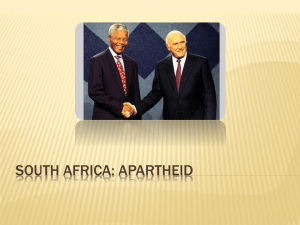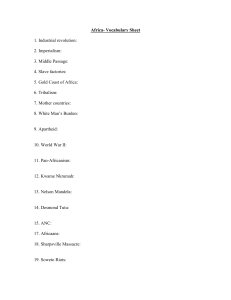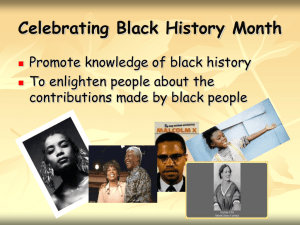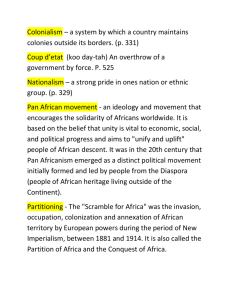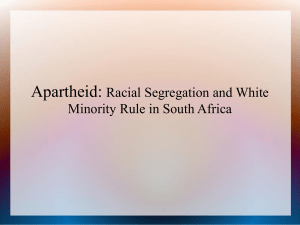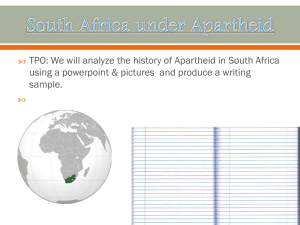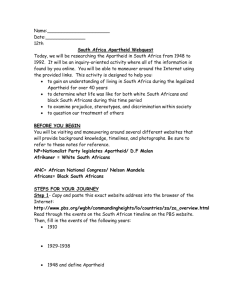Student Reading 1: Apartheid and Its Opponents
advertisement
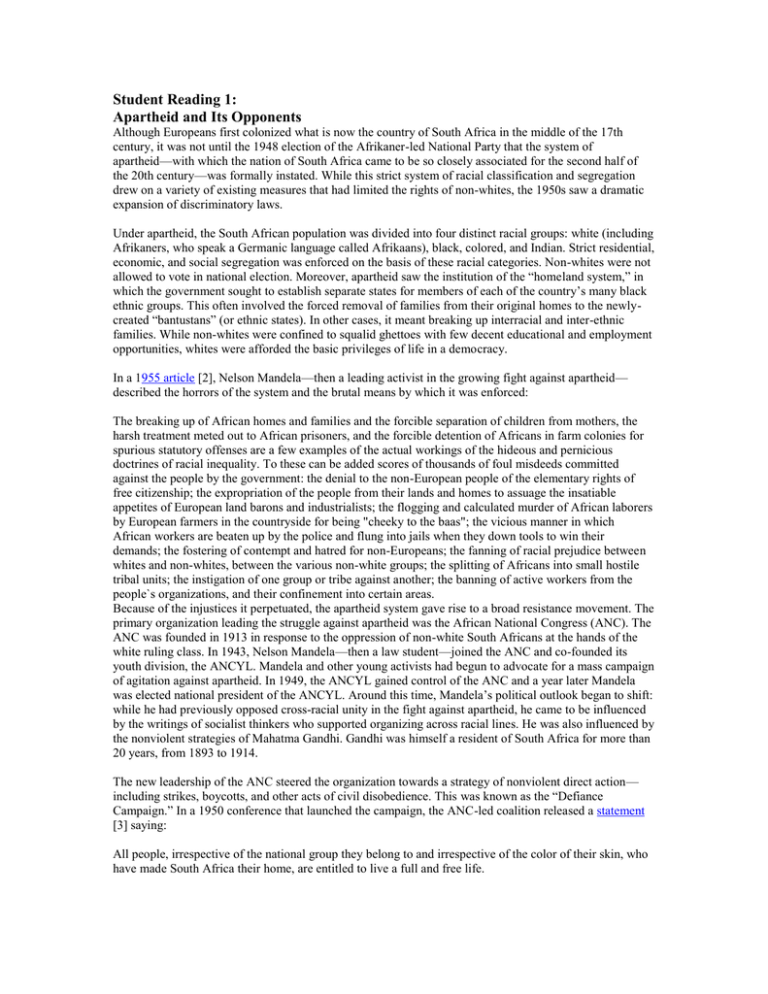
Student Reading 1: Apartheid and Its Opponents Although Europeans first colonized what is now the country of South Africa in the middle of the 17th century, it was not until the 1948 election of the Afrikaner-led National Party that the system of apartheid—with which the nation of South Africa came to be so closely associated for the second half of the 20th century—was formally instated. While this strict system of racial classification and segregation drew on a variety of existing measures that had limited the rights of non-whites, the 1950s saw a dramatic expansion of discriminatory laws. Under apartheid, the South African population was divided into four distinct racial groups: white (including Afrikaners, who speak a Germanic language called Afrikaans), black, colored, and Indian. Strict residential, economic, and social segregation was enforced on the basis of these racial categories. Non-whites were not allowed to vote in national election. Moreover, apartheid saw the institution of the “homeland system,” in which the government sought to establish separate states for members of each of the country’s many black ethnic groups. This often involved the forced removal of families from their original homes to the newlycreated “bantustans” (or ethnic states). In other cases, it meant breaking up interracial and inter-ethnic families. While non-whites were confined to squalid ghettoes with few decent educational and employment opportunities, whites were afforded the basic privileges of life in a democracy. In a 1955 article [2], Nelson Mandela—then a leading activist in the growing fight against apartheid— described the horrors of the system and the brutal means by which it was enforced: The breaking up of African homes and families and the forcible separation of children from mothers, the harsh treatment meted out to African prisoners, and the forcible detention of Africans in farm colonies for spurious statutory offenses are a few examples of the actual workings of the hideous and pernicious doctrines of racial inequality. To these can be added scores of thousands of foul misdeeds committed against the people by the government: the denial to the non-European people of the elementary rights of free citizenship; the expropriation of the people from their lands and homes to assuage the insatiable appetites of European land barons and industrialists; the flogging and calculated murder of African laborers by European farmers in the countryside for being "cheeky to the baas"; the vicious manner in which African workers are beaten up by the police and flung into jails when they down tools to win their demands; the fostering of contempt and hatred for non-Europeans; the fanning of racial prejudice between whites and non-whites, between the various non-white groups; the splitting of Africans into small hostile tribal units; the instigation of one group or tribe against another; the banning of active workers from the people`s organizations, and their confinement into certain areas. Because of the injustices it perpetuated, the apartheid system gave rise to a broad resistance movement. The primary organization leading the struggle against apartheid was the African National Congress (ANC). The ANC was founded in 1913 in response to the oppression of non-white South Africans at the hands of the white ruling class. In 1943, Nelson Mandela—then a law student—joined the ANC and co-founded its youth division, the ANCYL. Mandela and other young activists had begun to advocate for a mass campaign of agitation against apartheid. In 1949, the ANCYL gained control of the ANC and a year later Mandela was elected national president of the ANCYL. Around this time, Mandela’s political outlook began to shift: while he had previously opposed cross-racial unity in the fight against apartheid, he came to be influenced by the writings of socialist thinkers who supported organizing across racial lines. He was also influenced by the nonviolent strategies of Mahatma Gandhi. Gandhi was himself a resident of South Africa for more than 20 years, from 1893 to 1914. The new leadership of the ANC steered the organization towards a strategy of nonviolent direct action— including strikes, boycotts, and other acts of civil disobedience. This was known as the “Defiance Campaign.” In a 1950 conference that launched the campaign, the ANC-led coalition released a statement [3] saying: All people, irrespective of the national group they belong to and irrespective of the color of their skin, who have made South Africa their home, are entitled to live a full and free life. Full democratic rights with direct say in the affairs of the government are the inalienable right of every South African - a right which must be realized now if South Africa is to be saved from social chaos and tyranny and from the evils arising out of the existing denial of the franchise of vast masses of the population on the grounds of race and color. The struggle which the national organizations of the non-European people are conducting is not directed against any race or national group. It is against the unjust laws which keep in perpetual subjection and misery vast sections of the population. It is for the creation of conditions which will restore human dignity, equality and freedom to every South African. Mandela later recalled of the effort: Prior to the campaign, the ANC was more talk than action. We had no paid organizers, no staff, and a membership that did little more than pay lip-service to our cause. As a result of the campaign… the ANC emerged as a truly mass-based organization with an corps of experienced activists who had braved the police, the courts, and the jails…. From the Defiance Campaign onward, going to prison became a badge of honor among Africans. (The Long Walk To Freedom, Abacus Edition, pg. 159). During their nonviolent resistance, many protesters were rounded up and arrested as the government moved to outlaw any opposition. Mandela and several colleagues were arrested in the 1950s, but they were ultimately acquitted at the end of a long treason trial in 1961. In an attempt to squash resistance, the South African government also resorted to violent repression. The bloodiest incident was in 1960, when police opened fire on a group of 7000 protesters in the town of Sharpeville, killing 69 of them. In response to this growing repression by security forces and the clampdown on nonviolent forms of dissent, Mandela and other ANC leaders decided that the movement should have an armed wing, similar to other revolutionary movements against colonialism in Africa at the time. In the early 1960s, Mandela traveled internationally to raise money for an armed struggle. The armed wing of the ANC (Umkhonto we Sizwe, or Spear of the Nation) carried out acts of sabotage designed to destroy government property without killing civilians—detonating bombs to destroy government military installations, transportation infrastructure, and power plants. In two trials in 1962 and 1963, Mandela was found guilty of inciting workers’ strikes and sabotage and conspiracy to violently overthrow the government. He was sentenced to life in prison and spent the next 27 years of his life behind bars, often under brutal conditions. While in prison, Mandela and other political prisoners engaged in many political debates and discussion. The prison on Robben Island, where Mandela stayed for 20 years, was sometimes called "University of Robben Island." Although he was sidelined from direct participation in the movement while in prison, Mandela became a symbol—both in South Africa and internationally—of the struggle against injustice. During his imprisonment on Robben Island, the fight against apartheid continued. New organizations and leaders emerged to advance the cause, and thousands of average South Africans risked their lives to resist the brutal system. A powerful international movement included boycotts and bans of South African goods; protests, including massive civil disobedience; and an explosion of music and art demanding the end of apartheid and the freeing of Nelson Mandela and other political prisoners. Violence and instability grew within South Africa. The apartheid government faced increasing domestic and international pressure. In 1985, then President P.W. Botha offered to release Mandela from prison if he agreed to "unconditionally reject violence as a political weapon." Mandela refused the offer. He wrote: "What freedom am I being offered while the organization of the people [the ANC] remains banned? Only free men can negotiate. A prisoner cannot enter into contracts." Despite his recognition as a central figure in the fight against apartheid, Mandela has always been quick to note that he was not personally responsible for its overthrow. As he said upon his release from prison in 1990: [4] “I stand here before you not as a prophet but as a humble servant of you, the people. Your tireless and heroic sacrifices have made it possible for me to be here today. I therefore place the remaining years of my life in your hands.” For Discussion: 1. 2. 3. 4. 5. Do students have any questions about the reading? How might they be answered? According to the reading, what were some of the defining features of the apartheid system? How did young people influence the mounting struggle against apartheid in the 1950s? What was the Defiance Campaign and what were its aims? Many South Africans took action against apartheid despite great risk to themselves and their families. Are there any causes or issues that are important enough to you today that would motivate you to speak out, even at personal risk? Source URL: http://www.morningsidecenter.org/teachable-moment/lessons/nelson-mandela-fight-againstapartheid Links: [1] http://www.morningsidecenter.org/users/mark-engler [2] http://www.anc.org.za/show.php?id=4833 [3] http://www.sahistory.org.za/article/defiance-campaign-1952-social-struggle-or-party-stratagem-articlesand-papers [4] http://www.cnn.com/2010/WORLD/africa/02/11/south.africa.mandela/index.html [5] http://articles.philly.com/1990-06-11/news/25911294_1_afrikaners-gevaar-black-danger [6] http://www.nytimes.com/books/01/05/27/reviews/010527.27wolflt.html [7] http://www.philly.com/philly/blogs/trudy-rubin/210766232.html#vZ4F6C8r5R8jjEAp.99 [8] http://articles.philly.com/1997-01-30/news/25557788_1_white-right-wing-extremists-anc-mandela

